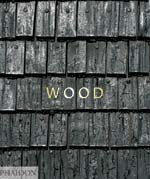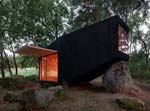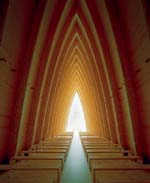
|

|
|
Home Site Search Contact Us Subscribe
|
|
Book Review: Reading the Grain: "Wood" by William Hall Designer William Hall's photographic essay of wood architecture spanning a 1,000 years broadens thinking about a trendy material so it appears as an ever-changing, perennial, and crucial one. By Norman Weinstein June 29, 2017 Although for the past century, steel, glass, and concrete have been the most prevalent building materials, wood has never completely lost its measure of popularity as a prime architectural choice, particularly in the realm of custom homes and religious architecture. In fact, think of the very real pleasure, increasingly scarce for the less well-heeled among us, of purchasing “real wood” furniture, a point recently driven home for me when I bought a cheap bookcase that arrived with a backing of genuine wood-grain printed cardboard! William Hall's Wood offers a respite and escape from the insult of acquiring ersatz-wood, offering a refined, fine-grained vision of how positively transformative wood designs can be in global architecture today.
Arguably, wood is the most ancient of materials used for humankind’s first shelters when it abandoned cave dwellings. Unlike stone, it readily changes within an average lifetime, and often gains layers of beauty and historical and environmental data in that metamorphosis. Unlike steel and concrete, it is a dream material for the DIY masses, requiring few tools to work into, say, a simple wood cabin. In our time of pressing climate change issues, it is the most carbon-neutral of materials an architect can design with. Plus it is increasingly being engineered, molecularly modified, so it gains strength, resiliency, and even potentially, transparency.
What designer William Hall has done with all of these facts regarding wood architecture is stunning and revelatory. Using 170 select examples of wood architecture culled globally throughout a period of a 1,000 years, he has meticulously crafted an inspirational and thought-provoking photographic essay. This essay in imagery is prefaced by an informative introductory essay by U.K.- based writer Richard Mabey, an inviting “ramble in the woods” (forgive pun) reflecting Mabey’s interests as a naturalist, broadcaster, and inhabitant of a 16th-century half-timbered farmhouse in Norfolk. Each project is presented in a coffee-table book-sized photograph, captioned by Hall with brief basic information about the architect (when known, a reminder of the depth of the vernacular history of wood architecture), site location, and a sentence or two that says just enough to arouse curiosity and measured speculation.
Contrast Hall’s Wood with several recent books from Taschen by Philip Judidio, Wood Architecture Now and 100 Contemporary Wood Buildings. These are contemporary catalogues of worthy examples of solely modern wooden buildings with largely factual captions to help you keep up with recent trends and trendsetters architecturally. This is just fine – if you don’t care about the historical context for today’s wooden trends. And if you want a quick read, with photos less lyrically evocative and curiosity-provoking than Hall’s, Judidio’s books might be welcome. Hall’s book is for readers wanting more.
Wood is Hall’s third in a series in which the form of a refined photographic essay makes the book an object for deep architectural meditation on key materials. His earlier titles, Concrete and Brick (Phaidon, 2012 and 2015), resemble Wood in format. The trio comprise a primer of the myriad roles critical materials have played in global architectural history while using minimal yet curiosity-inducing text. A feat by any measure. Phaidon should sell these three hardbound books, reasonably priced at $50 each, as a boxed paperback set, so interlocked are their concerns, and so enthralling the author’s rare minimalist sensibility. Wood welcomes you into the wooden worlds of a medieval Japanese villa, a Finnish Ecumenical chapel, and a Norwegian farmhouse (with upper-level bedrooms planned for unmarried women). There’s Le Corbusier’s single-room wood cabin where he relaxed for 12 summers. There’s Sou Fujimoto’s “Final Wooden House” constructed from lengths of 14-inch solid timber, a surrealistic abode where the conventional forms of floor, ceiling, and furniture are radically reformulated and repurposed. And an astonishing Bird Observation Tower designed by Architekten von Gerkan that evokes the sweeping aerodynamic energy of an avian in flight.
Behind every architectural fad lurks hidden poems and stories. With an exacting eye and discerning designer’s intellect, William Hall brings those secret poems and stories to light.
Norman Weinstein is the author of “Words That Build” – an exclusive 21-part ArchNewsNow.com series about writing as a keystone of a successful architectural practice. He's authored several books of poetry and books about music and literature. Weinstein is currently learning weaving in order to deepen his understanding of architecture, music, and poetry. He can be reached at nweinstein25@gmail.com..
More by Weinstein:
An exclusive 21-part series that focuses on the overlooked foundations of architecture: oral and written communication.
Weinstein: From Ada to Zaha and Everything In Between Op-eds, book reviews, musings, and debate.
. |
(click on pictures to enlarge)  Phaidon “Wood” by William Hall (Phaidon, March 2017, $49.95)  ©Heiner Leiska Bird Observation Tower, Graswarder-Heiligenhafen, Germany, Architekten von Gerkan, Marg und Partner, 2005 (page 92-3)  ©Jan Kud?j Forest Retreat, Central Bohemian Region, Czech Republic, Uhlik Architekti, 2013 (page 35)  ©Jussi Tiainen St Henry's Ecumenical Art Chapel, Turku, Finland, Sanaksenaho Architects, 2005 (page 127) |
© 2017 ArchNewsNow.com